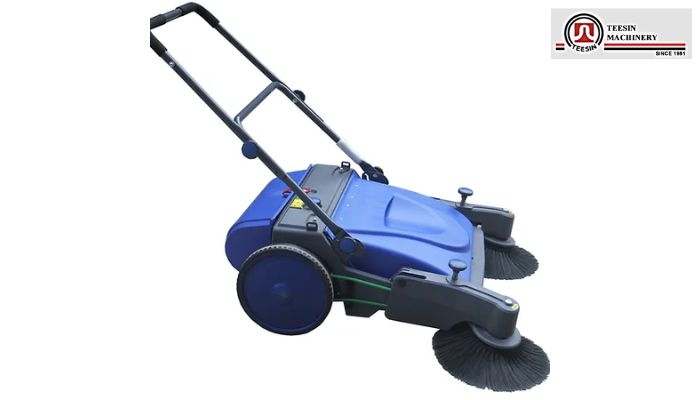
Construction sites are dynamic environments where keeping the area clean and safe is crucial. Amidst the daily activities, manual sweepers emerge as an efficient solution for maintaining these sites. These tools are not only straightforward to use but also enhance safety and productivity. In this discussion, we delve into the significance of manual sweepers in construction site maintenance, exploring their functionality and benefits.
A manual sweeper is a simple, non-motorized device designed to collect debris like dust, dirt, and small waste materials. It consists of brushes that rotate to sweep up the debris into a collection bin. With its user-friendly design, it requires minimal training, making it a go-to choice for many construction sites.
In comparison to other cleaning methods, manual sweepers offer a blend of simplicity and efficiency. They are easy to manoeuvre around various obstacles commonly found on construction sites. Additionally, their low-cost investment and maintenance make them an economically favourable option.
Exploring the Key Benefits of Manual Sweepers for Construction Sites
There are several manual sweeper advantages, and their impact on operational efficiency, safety, and cost management is significant.
Simplicity and Ease of Use
The simplicity of manual sweepers is one of their most alluring qualities. Employees don’t require much training to operate them; they can pick them up fast. Because of its simplicity of use, cleaning activities are completed quickly and effectively.
Cost-Effectiveness
From a financial standpoint, manual sweepers are a smart choice. They are generally more affordable than their automated counterparts and incur lower maintenance costs. This affordability makes them accessible to a wider range of construction projects, from small-scale renovations to large developments.
Safety Enhancements
Safety on construction sites is paramount. Manual sweepers contribute to a safer work environment by effectively removing potential hazards like loose debris, which can cause slips or equipment malfunctions. Their quiet operation also ensures that communication among workers is not hindered, a crucial factor in maintaining site safety.
Comparative Analysis: Manual Sweepers vs. Automated Cleaning Equipment
When weighing the options between manual sweepers and automated cleaning equipment, several factors come into play. Let’s compare these two to understand their respective strengths and limitations.
Operational Simplicity
Manual sweepers win in terms of operational simplicity. They don’t rely on power sources or complex mechanisms, making them more reliable in various site conditions. In contrast, automated equipment often requires specific settings and adjustments, which can be time-consuming and require specialized knowledge.
Maintenance and Repairs
The simplicity of manual sweepers also translates to easier maintenance. They have fewer mechanical parts, reducing the likelihood of breakdowns and the need for complex repairs. Automated sweepers, on the other hand, can incur higher maintenance costs and downtime due to their intricate components.
Suitability for Different Site Conditions
While automated sweepers can be efficient for large, open spaces, they may not be as effective in tight or congested areas often found in construction sites. Manual sweepers, with their compact design and ease of manoeuvrability, can efficiently clean around obstacles and in smaller spaces.
How Manual Sweepers Contribute to Environmental Sustainability
In today’s world, where environmental concerns are at the forefront, manual sweepers are more than just cleaning tools; they’re a step towards a greener planet. These sweepers operate without fuel or electricity, drastically cutting down carbon emissions that are typically associated with motorized cleaning equipment. This aspect not only makes them energy-efficient but also significantly reduces noise pollution, a common issue in urban construction sites.
Reducing Carbon Footprint and Noise Pollution
The absence of engines in manual sweepers means there are no fumes or exhaust gases released during their operation. This feature is crucial in minimizing the carbon footprint of construction site maintenance. Equally important is their quiet operation. In contrast to their motorized counterparts, manual sweepers work silently, making them ideal for use in noise-sensitive areas.
Eco-Friendly Waste Handling
Beyond their operation, manual sweepers encourage eco-friendly waste disposal practices. The debris collected is often non-hazardous and can be sorted and recycled with ease. This method of waste handling aligns with sustainable practices, reducing the amount of waste sent to landfills.
Incorporating Manual Sweepers into Daily Construction Site Routines
Implementing manual sweepers into daily routines can enhance the efficiency of construction site maintenance while being environmentally responsible. Establishing a regular cleaning schedule ensures that sites remain tidy and safe, without imposing a significant environmental impact.
Developing Effective Cleaning Schedules
Creating a cleaning schedule that aligns with the construction site’s operational hours is vital. This schedule ensures that sweeping is done consistently, maintaining a clean and organized site. Regular maintenance of these sweepers is minimal, allowing for uninterrupted cleaning routines.
Training for Optimal Use
While manual sweepers are straightforward to operate, providing basic training for workers ensures they are used efficiently. A short training session can cover proper sweeping techniques, debris disposal, and basic maintenance checks.
Long-term Manual Sweeper Advantages and Its Durability
The long-term durability and affordability of manual sweepers are among the strongest justifications for selecting them. These instruments are made to endure the demanding circumstances found on building sites, guaranteeing years of use with little upkeep.
Durability in Harsh Environments
Constructed with robust materials, manual sweepers can endure the abrasive nature of construction debris and varying weather conditions. Their mechanical parts are less prone to wear and tear compared to motorized alternatives, meaning fewer repairs and replacements.
Long-Term Cost Savings
The initial investment in a manual sweeper is often lower than that for a motorized one. Additionally, the absence of fuel or electricity costs and minimal maintenance needs translate to significant long-term savings.
Selecting the Right Manual Sweeper for Your Construction Site
Choosing the appropriate manual sweeper is critical for maximizing its benefits. Consideration of the site’s size, terrain, and the type of debris encountered is key in making an informed decision.
Factors to Consider
- Size of the Site: Larger sites might require sweepers with wider coverage, while smaller, more congested areas might benefit from compact models.
- Terrain: Uneven surfaces may need sweepers with larger, more durable wheels.
- Type of Debris: Heavier debris will require sweepers with robust brushes and larger collection bins.
Brand and Model Recommendations
Researching different brands and models is crucial. Seek out models known for their durability and efficiency. User reviews and industry recommendations can provide valuable insights into the best options available.
User Reviews and Feedback
Testimonials from people who have used the product could be extremely helpful in determining the real-world advantages and possible disadvantages of certain models.
Read Also – The Key Benefits Of Construction Equipment Rental




